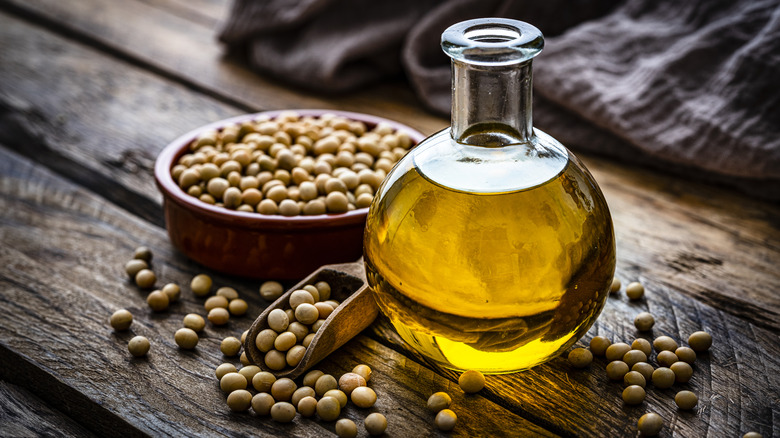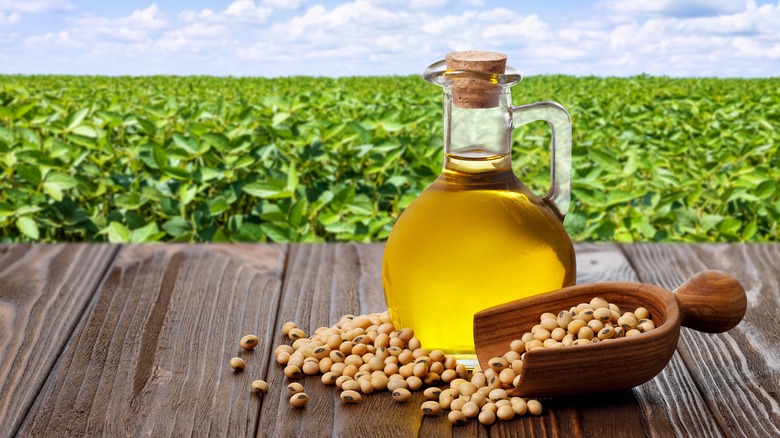You'll Probably Never Guess What Vegetable Oil Actually Is
In the realm of cooking oils, many have self-explanatory names, such as olive oil or peanut oil, clearly indicating their source. However, the term "vegetable oil" can be a bit more vague. It's not always readily apparent which vegetables are being used, and in what proportions. This ambiguity partly arises because the term "vegetable oil" encompasses a variety of subgroups.
Vegetable oil is generally defined as any oil made from nuts, seeds, grains, or fruit. This means that almost all commercial cooking oils available in stores, including sunflower seed oil, olive oil, and canola oil, are categorized under the vegetable oil umbrella. But what about bottles simply labeled as "vegetable oil"? More often than not, these contain soybean oil, or a blend of soybean oil with other plant-based oils. One reason these particular oils are grouped under the broad "vegetable oil" label is because soybean oil used to have a negative public perception.
The big soy secret of vegetable oil
When you choose a plain oil marked as vegetable oil in the US, there's a fairly high chance it's pure soybean oil. If not, it's likely a blend of soybean oil with other common vegetable oils, such as peanut or corn. Why is soybean oil often used this way? Part of it involves marketing. Soy has had a negative health reputation in the past. According to Montana State University, there have been media claims that soy consumption may lead to hormone imbalances and even breast cancer, though these claims lack substantial evidence. Interestingly, many purported negative qualities of soy have been downplayed in recent years, but for consumers, "vegetable oil" remains a more appealing label than "soybean oil."
The term "vegetable oil" also allows companies to mix different oils without changing the label. This is feasible since many seeds, legumes, and other plant oils share a similar yellow hue and are hard to distinguish visually. Originally, the distinction of vegetable oil served to separate plant-based oils from animal-based ones. However, as time and business practices have evolved, the classification of vegetable oil has increasingly come to refer specifically to soybean oil.
Cooking and baking properties of vegetable oil
There are several reasons why many recipes, both in baking and cooking, call for a bit of vegetable oil. Unlike peppery olive oil or buttery avocado oil, vegetable oil has almost no flavor, making it ideal for adding moisture to cakes without imparting a strong taste. Similarly, it won't affect the flavor of your vegetable saute. Its mild taste also makes vegetable oil a suitable choice for non-cooking uses, such as in homemade mayonnaise, marinades, and salad dressings.
Equally important is the fact that vegetable oil is a high-heat oil with a smoke point of about 400-450 degrees Fahrenheit. When cooking at extremely high temperatures, such as those required for stir-frying in a wok, you won't have to worry about the oil burning and smoking like more sensitive oils, such as olive oil. This high smoke point also means you can often reuse the oil after frying, provided you strain out any lingering food particles.
For the most consistent experience with vegetable oil, try to purchase one that's 100% soybean oil, rather than a mix of different oils, as each type behaves differently in terms of flavor and heat sensitivity. Soybean vegetable oil is most similar to canola oil, made from rapeseed, and they can be used interchangeably if you need a substitute.



